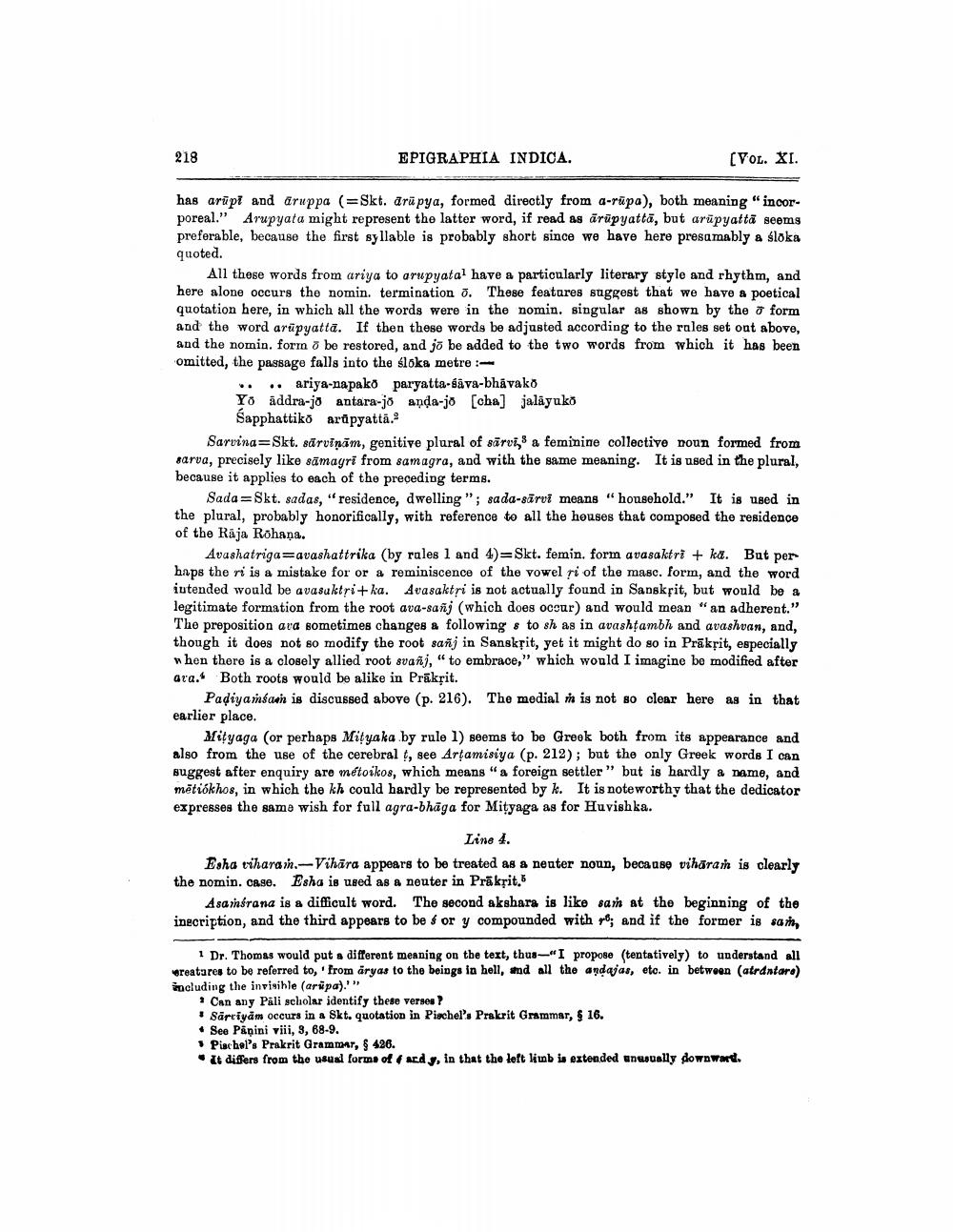________________
218
EPIGRAPHIA INDICA.
(VOL. XI.
has arūpi and aruppa (=Skt. drūpya, formed directly from a-rūpa), both meaning "incorporeal." Arupyata might represent the latter word, if read as ārūpyatta, but arūpyattā seems preferable, because the first syllable is probably short since we have here presamably a sloka quoted.
All these words from ariya to arupyatal have a particularly literary style and rhythm, and here alone occurs the nomin. termination 7. These features suggest that we have a poetical quotation here, in which all the words were in the nomin. singular as shown by the form and the word arūpyatta. If then these words be adjusted according to the rales set out above, and the nomin. forma o be restored, and jā be added to the two words from which it has been omitted, the passage falls into the sloka metre:
.. . ariya-napako paryatta-såva-bhävako Yo addra-jo antara-jo anda-jo [cha) jalayuko
Sapphattiko arūpyatta. Sarvina=Skt. sārvīnām, genitive plural of sārvi, a feminine collective noun formed from sarva, precisely like sāmayri from samagra, and with the same meaning. It is used in the plural, because it applies to each of the preceding terms.
Sada=Skt. sadas, residence, dwelling"; sada-sārvi means "household." It is used in the plural, probably honorifically, with reference to all the houses that composed the residence of the Raja Rohana.
Avashatrigaravashattrika (by rales 1 and 4)=Skt. femin. form avasaktri + ka. But per haps the ri is a mistake for or a reminiscence of the vowel si of the masc. form, and the word iutended would be avasuktsi+ka. Avasaktņi is not actually found in Sanskrit, but would be a legitimate formation from the root ava-sanj (which does occur) and would mean "an adherent." The preposition ava sometimes changes a following s to sh as in avashtambh and avashvan, and, though it does not so modify the root sanj in Sansksit, yet it might do so in Prākrit, especially When there is a closely allied root svani, "to embrace," which would I imagine be modified after ara. Both roots would be alike in Prakrit.
Padiyamsan is discussed above (p. 216). The medial n is not so clear here as in that earlier place.
Mityaga (or perhaps Mityaka by rule 1) seems to be Greek both from its appearance and also from the use of the cerebral !, see Arļamisiya (p. 212); but the only Greek words I can suggest after enquiry are métoikos, which means "a foreign settler" but is hardly a mame, and mētiókhos, in which the kh could hardly be represented by k. It is noteworthy that the dedicator expresses the same wish for full agra-bhāga for Mityaga as for Huvishka.
Line 4. Esha viharan.-Vihāra appears to be treated as a neuter noun, because vihāram is clearly the nomin. case. Esha is used as a neuter in Prakrit,
Asainsrana is a difficult word. The second akshara is like san at the beginning of the inecription, and the third appears to be $ or y compounded with eve; and if the former is sain
1 Dr. Thomas would put a different meaning on the text, thus-"I propose (tentatively) to understand all creatares to be referred to, from aryas to the beings in hell, and all the andajas, etc. in between (atrdntara) including the invisible (arüpa).'"
Can any Pāli scholar identify these verses?
Sārciyam occurs in a Skt. quotation in Pirchel's Prakrit Grammar, & 16. • See Påņini viii, 3, 68-9.
Piachel's Prakrit Grammar, $426. • It differs from the usual forms of acd, in that the left lub is extended unusually downward.




